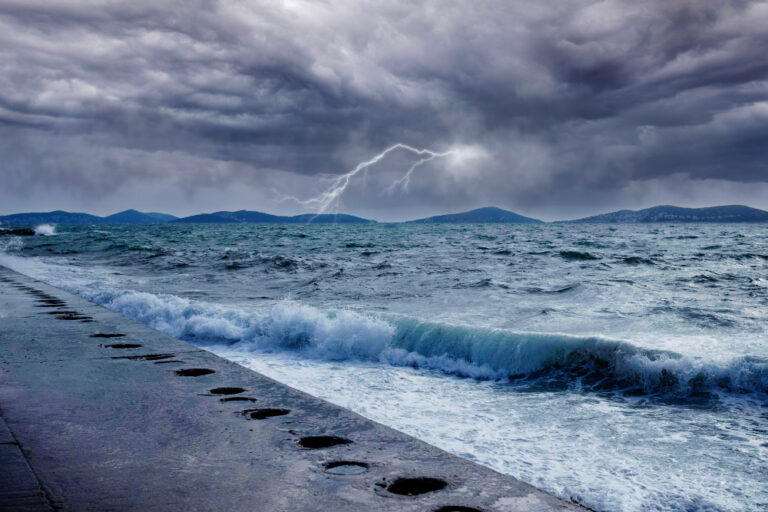The Strategic Importance of the South China Sea for the Philippines and China
Welcome to our blog post on the strategic importance of the South China Sea for both the Philippines and China! In this article, we will delve into the complex history of territorial disputes in this region, explore the significance it holds for each country, and discuss its geostrategic implications. So grab a cup of coffee and join us as we navigate these turbulent waters! The South China Sea has long been a hotbed of tension and contention a geopolitical chessboard where conflicting interests collide. Let’s dive right in!
Background and Territorial Disputes
The South China Sea, a vast body of water stretching over 3.5 million square kilometers, is home to numerous islands, reefs, and resources. However, it has become a focal point of territorial disputes between several countries in the region. For decades, China, the Philippines, Vietnam, Malaysia, Taiwan, and Brunei have claimed sovereignty over various parts of these waters.
History of Territorial Disputes in the South China Sea
The South China Sea has been a hotbed of territorial disputes for centuries. The history of these conflicts dates back to ancient times, when varioushttps://globalconreview.com/ empires and kingdoms claimed control over the strategic waterway. In more recent history, tensions have escalated as multiple countries, including China and the Philippines, assert their sovereignty over different islands and reefs in the region.
These disputes have been fueled by historical claims, competing interests in natural resources such as oil and gas reserves, and geopolitical considerations. The complex nature of these conflicts has made finding a lasting resolution challenging. As we delve deeper into the issue, it becomes clear that understanding the historical context is essential to comprehending the current dynamics at play in this strategically important area of the world.
South China Sea Arbitration Case
The South China Sea Arbitration Case has been a major point of contention between the Philippines and China. The case was brought to the Permanent Court of Arbitration in 2013, challenging China’s claims over certain areas in the South China Sea. In July 2016, the court ruled in favor of the Philippines, stating that China’s claims had no legal basis under international law.
This ruling sparked further tensions between the two countries, with both sides refusing to back down. It highlighted the deep-rooted territorial disputes and competing interests in this strategic region. The arbitration case not only exposed the complexities of resolving these issues but also raised questions about how other nations would respond to this dispute.
Chinese Policy on the South China Sea
China’s policy on the South China Sea is a topic of significant interest and concern for both regional and global stakeholders. The Chinese government maintains its sovereignty claims over nearly the entire area, based on historical records dating back centuries. This stance has led to territorial disputes with neighboring countries such as Vietnam, the Philippines, and Malaysia.
In recent years, China has taken assertive actions to reinforce its claims in the region. It has constructed artificial islands and deployed military assets, raising tensions among other claimant states and attracting international attention. These actions have been met with criticism from countries like the United States and Japan, who argue that they violate international law by infringing upon freedom of navigation in the disputed waters.
Importance for the Philippines
Energy Exploration Projects in the South China Sea have significant importance for the Philippines. With rich oil and gas reserves believed to lie beneath its waters, the country views this as a potential source of economic growth and energy security. However, these projects are not without their challenges. Tensions and collisions in contested waters have raised concerns about safety and sovereignty, while China’s aggressive stance adds another layer of complexity. Despite these obstacles, the Philippines has received support from the United States, which has conducted joint military exercises and provided assistance to enhance its maritime capabilities.
The strategic location of the South China Sea also plays a crucial role for the Philippines’ national interests. It serves as a gateway to international trade routes, making it vital for ensuring smooth commerce flow and maintaining regional stability. Additionally, territorial disputes jeopardize fishing grounds that provide livelihoods for many Filipino fishermen who depend on these waters for sustenance. The ongoing tensions between China and other claimant countries highlight how critical it is for the Philippines to protect its maritime rights while seeking peaceful resolutions through diplomatic channels.
Energy Exploration Projects in the South China Sea
The South China Sea is a hotbed of energy exploration projects, attracting countries like the Philippines and China. With vast reserves of oil and natural gas believed to lie beneath its waters, it’s no wonder that these nations are eager to tap into this valuable resource.
For the Philippines, energy exploration in the South China Sea holds great promise for economic growth and energy security. The country has been actively exploring its own exclusive economic zone (EEZ) in the disputed region, seeking partnerships with foreign companies to develop offshore oil and gas fields. However, these endeavors have not come without challenges as they often face opposition from other claimant countries who assert their own territorial claims.
China too has a vested interest in energy exploration projects in the South China Sea. As one of the largest consumers of energy globally, securing access to additional oil and gas reserves is crucial for its continued development. Through strategic investments and infrastructure development, China aims to enhance its capabilities for offshore drilling and resource extraction within disputed areas.
Both countries understand that successful energy exploration projects could bring significant economic benefits by reducing dependence on imported resources while bolstering national revenue through exports. Nonetheless, tensions surrounding competing claims over territories continue to complicate efforts towards cooperation and compromise.
Tensions and Collisions in Contested Waters
Tensions and collisions in the contested waters of the South China Sea have become a flashpoint for regional conflict. As multiple countries claim sovereignty over various islands and reefs, clashes between fishing vessels, coast guards, and naval forces have escalated. These incidents often result in damaged ships, injuries, and even loss of life.
The disputed nature of these waters has made it difficult to establish clear rules and regulations for maritime activities. With competing territorial claims overlapping each other, encounters between different nations’ vessels can quickly escalate into dangerous situations. The risk of accidental collisions or miscalculations. Leading to armed conflicts is a constant concern for all parties involved. The need for diplomatic negotiations and enhanced communication channels. To prevent such incidents from spiraling out of control cannot be overstated.
US. Support for the Philippines
In the midst of escalating tensions in the South China Sea, the United States has shown its unwavering support for the Philippines. The U.S. government recognizes the strategic importance of maintaining stability in this region and has made it clear that it stands with its long-standing ally.
Through military exercises and joint patrols, the U.S. demonstrates its commitment to ensuring freedom of navigation and promoting a rules-based order in these disputed waters. This support not only strengthens Philippine defenses but also sends a strong message to China that any aggressive actions will not go unchallenged. In this complex geopolitical landscape, the backing of a powerful ally like the United States provides a sense of security for the Philippines as they navigate through these challenging times.
Importance for China
China’s strategic importance in the South China Sea cannot be overstated. As one of the claimant countries, China has a vested interest in maintaining control over this disputed territory. For China, the South China Sea holds immense value both economically and strategically.
First and foremost, from an economic standpoint. The South China Sea is believed to hold vast reserves of oil and natural gas. These resources are crucial for fueling China’s growing energy needs and supporting its rapid economic development. By asserting control over these waters, China can secure its energy supply and gain a significant advantage in terms of resource exploration and extraction.
From a strategic perspective, the South China Sea plays a crucial role in safeguarding Chinese national interests and maritime security. Control over these waters allows China to project power beyond its immediate borders and establish dominance in the region. Additionally, controlling key shipping lanes through which trillions of dollars’ worth of trade passes annually gives Beijing significant leverage on global trade routes.
For China, maintaining control over the South China Sea is vital for economic prosperity as well as ensuring regional stability and influence.
Security and National Interests
China’s security and national interests in the South China Sea are of paramount importance. As one of the world’s major powers, China views control over this strategic waterway as crucial for its own security. The South China Sea provides a vital maritime gateway for China’s trade routes and serves as a buffer zone between its mainland and potential threats from foreign powers.
In addition to security concerns, China also has economic interests at stake in the region. The South China Sea is rich in natural resources, including oil and gas reserves. By asserting control over these resources, China can secure its energy needs and reduce dependence on foreign suppliers. Furthermore, the sea also offers abundant fishing grounds that support local economies along its coastlines.
With these considerations in mind, it is clear why securing dominance in the South China Sea aligns with both Chinese security objectives and economic ambitions. However, this assertiveness has led to tensions with neighboring countries who have their own territorial claims in the disputed waters. These disputes raise concerns about potential military conflicts or escalations that could disrupt regional stability.
It is important for all parties involved to find peaceful resolutions through diplomacy. And dialogue to ensure long-term stability in the region without compromising each nation’s security interests.
Oil and Gas Development in the South China Sea
Oil and gas development in the South China Sea is a significant factor in the ongoing territorial disputes between the Philippines and China. The region is believed to hold vast reserves of oil and natural gas. Making it a highly sought-after resource for both countries. Extraction and exploration projects have been underway for years, leading to increased tensions as each side seeks to assert its rights over these valuable resources.
Both the Philippines and China have conducted offshore drilling operations in contested waters, further fueling their dispute. The potential economic benefits from oil and gas extraction are immense, prompting both countries to invest heavily in developing this sector. However, these efforts have also contributed to heightened geopolitical tensions as neighboring nations worry about encroachment on their own claims. With so much at stake economically and strategically, it’s no wonder that energy development plays such a crucial role in the South China Sea disputes
Regional Diplomatic Relations
In the midst of territorial disputes in the South China Sea, regional diplomatic relations have become increasingly complex. The Philippines and China, along with other claimant countries such as Vietnam and Malaysia, have engaged in intensive negotiations and discussions to find a peaceful resolution to the conflicts. These talks have involved multilateral forums like ASEAN, where member states strive to maintain stability and promote cooperation in the region.
However, tensions often arise due to differing interests and historical grievances. Disagreements over maritime boundaries and resource exploitation further strain these relations. As a result, diplomatic efforts are crucial for fostering understanding among nations and preventing escalations that could potentially jeopardize regional stability.
Geostrategic Implications
The geostrategic implications of the South China Sea dispute extend far beyond the borders of the Philippines and China. It is a complex issue that has attracted attention from countries around the world. Non-claimant states, such as the United States, Japan, and Australia, have expressed concerns about China’s assertiveness in the region, fearing it could lead to increased tensions or even armed conflict.
These countries see the South China Sea as a critical shipping route and economic hub, with billions of dollars’ worth of goods passing through its waters each year. They are worried that any disruption to trade routes. Or escalation of hostilities could have severe repercussions for global trade and stability. As a result, they have called for peaceful resolutions. To be pursued through diplomatic channels rather than military force.
Non-Claimant Views and Third-Party Analysis
It’s not just the Philippines and China that have a stake in the South China Sea. Many countries around the world closely monitor the developments in this disputed region, as it has significant implications for global trade and security. Non-claimants such as the United States, Japan, Australia, and others have expressed concerns about China’s assertiveness in the area.
These countries view freedom of navigation and adherence to international law as crucial principles. That must be upheld in navigating these waters. They advocate for peaceful resolution of disputes through dialogue and diplomatic channels. Additionally, independent think tanks and analysts offer valuable insights into this complex issue, shedding light on historical context, legal interpretations, regional power dynamics, and potential risks involved. Their analysis helps shape informed discussions and policy decisions on how to manage tensions effectively without escalating conflicts further.
U.S. and Chinese Concerns About Intervention
Both the United States and China have expressed concerns about potential foreign intervention in the South China Sea dispute. The U.S. worries that increased tensions could lead to a conflict that threatens regional stability, while China sees any external interference as an infringement on its sovereignty.
For the U.S., maintaining freedom of navigation in the region is crucial to its strategic interests and upholding international law. It fears that any military confrontation or escalation could draw it into a direct conflict with China, which has been expanding its military presence in the area.
China, on the other hand, views any outside involvement as meddling in what it considers to be internal affairs. It argues that disputes should be resolved through peaceful negotiations between directly involved parties and opposes any attempts by other countries or international organizations to impose their will.
As tensions continue to rise, both sides are closely monitoring each other’s actions and rhetoric for signs of escalating aggression or provocation. The possibility of third-party intervention remains a delicate issue that further complicates an already complex territorial dispute.
Options for a U.S. Response to Rising Tensions
As tensions continue to rise in the South China Sea, it is crucial to consider the various options available for a U.S. response. One option is to strengthen alliances and partnerships with other countries in the region that share similar concerns about Chinese expansionism. By forming closer ties with nations such as Japan, Australia, and Vietnam, the U.S. can send a strong message of solidarity against any aggressive actions by China.
Additionally, another option for the U.S. is to increase its presence and military capabilities in the region. This could involve conducting more frequent naval patrols and exercises near disputed areas, as well as deploying additional resources such as aircraft carriers or submarines. By demonstrating a robust military presence, the U.S. can deter any potential aggression from China and ensure freedom of navigation for all parties involved in these contentious waters.
Conclusion and Future Prospects
The South China Sea holds immense strategic importance for both the Philippines and China. The history of territorial disputes in the region, as well as the recent South China Sea arbitration case, have heightened tensions and underscored the need for a diplomatic resolution.
For the Philippines, the South China Sea is vital for its energy exploration projects. The potential resources in these contested waters are crucial for its economic growth and energy security. However, ongoing tensions and collisions with other claimant countries pose significant challenges.
China’s perspective on the South China Sea is driven by national interests and security concerns. Its military presence in disputed areas can be seen. As a way to safeguard vital sea lanes of communication while asserting dominance over maritime territories it claims. Additionally, oil and gas development in these waters supports China’s growing energy demands.
However, regional diplomatic relations remain complex due to overlapping territorial claims. Disputes with neighboring countries such as Vietnam and Malaysia have strained relationships within Southeast Asia. Chinese actions often draw criticism from non-claimant nations who view them as threats to freedom of navigation.
This geostrategic situation raises concerns among different parties involved, including those outside the region like the United States. Both Washington and Beijing fear that intervention could escalate conflicts further or even lead to a direct confrontation between great powers – an outcome neither side desires.
Considering these factors, there are various options for how tensions can be managed moving forward. Diplomatic negotiations accompanied by confidence-building measures could help ease tensions between claimants while avoiding armed conflict.







